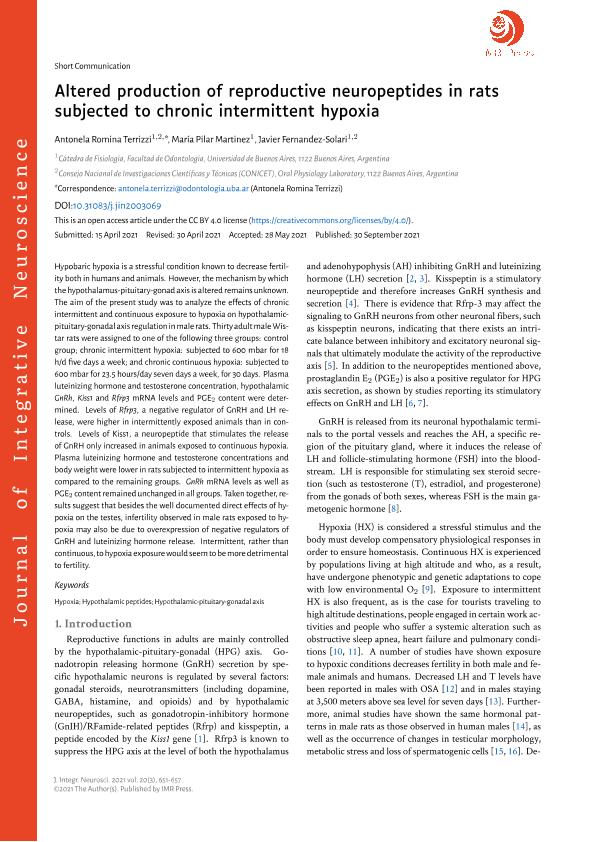Mostrar el registro sencillo del ítem
dc.contributor.author
Terrizzi, Antonela Romina

dc.contributor.author
Martínez, María Pilar

dc.contributor.author
Fernández Solari, José Javier

dc.date.available
2022-01-07T12:55:15Z
dc.date.issued
2021-09
dc.identifier.citation
Terrizzi, Antonela Romina; Martínez, María Pilar; Fernández Solari, José Javier; Altered production of reproductive neuropeptides in rats subjected to chronic intermittent hypoxia.; Karger; Neurosignals; 20; 3; 9-2021; 651-657
dc.identifier.issn
1424-8638
dc.identifier.uri
http://hdl.handle.net/11336/149769
dc.description.abstract
Hypobaric hypoxia is a stressful condition known to decrease fertility both in humans and animals. However, the mechanism by which the hypothalamus-pituitary-gonad axis is altered remains unknown. The aim of the present study was to analyze the effects of chronic intermittent and continuous exposure to hypoxia on hypothalamic-pituitary-gonadal axis regulation in male rats. Thirty adult male Wistar rats were assigned to one of the following three groups: control group; chronic intermittent hypoxia: subjected to 600 mbar for 18 h/d five days a week; and chronic continuous hypoxia: subjected to 600 mbar for 23.5 hours/day seven days a week, for 30 days. Plasma luteinizing hormone and testosterone concentration, hypothalamic GnRh, Kiss1 and Rfrp3 mRNA levels and PGE2 content were determined. Levels of Rfrp3, a negative regulator of GnRH and LH release, were higher in intermittently exposed animals than in controls. Levels of Kiss1, a neuropeptide that stimulates the release of GnRH only increased in animals exposed to continuous hypoxia. Plasma luteinizing hormone and testosterone concentrations and body weight were lower in rats subjected to intermittent hypoxia as compared to the remaining groups. GnRh mRNA levels as well as PGE2 content remained unchanged in all groups. Taken together, results suggest that besides the well documented direct effects of hypoxia on the testes, infertility observed in male rats exposed to hypoxia may also be due to overexpression of negative regulators of GnRH and luteinizing hormone release. Intermittent, rather than continuous, to hypoxia exposure would seem to be more detrimental to fertility.
dc.format
application/pdf
dc.language.iso
eng
dc.publisher
Karger

dc.rights
info:eu-repo/semantics/openAccess
dc.rights.uri
https://creativecommons.org/licenses/by-nc-sa/2.5/ar/
dc.subject
HYPOTHALAMIC PEPTIDES
dc.subject
HYPOTHALAMIC-PITUITARY-GONADAL AXIS
dc.subject
HYPOXIA
dc.subject.classification
Fisiología

dc.subject.classification
Medicina Básica

dc.subject.classification
CIENCIAS MÉDICAS Y DE LA SALUD

dc.title
Altered production of reproductive neuropeptides in rats subjected to chronic intermittent hypoxia.
dc.type
info:eu-repo/semantics/article
dc.type
info:ar-repo/semantics/artículo
dc.type
info:eu-repo/semantics/publishedVersion
dc.date.updated
2022-01-06T14:54:05Z
dc.journal.volume
20
dc.journal.number
3
dc.journal.pagination
651-657
dc.journal.pais
Suiza

dc.journal.ciudad
Basel
dc.description.fil
Fil: Terrizzi, Antonela Romina. Consejo Nacional de Investigaciones Científicas y Técnicas; Argentina. Universidad de Buenos Aires. Facultad de Odontología; Argentina
dc.description.fil
Fil: Martínez, María Pilar. Universidad de Buenos Aires. Facultad de Odontología; Argentina. Consejo Nacional de Investigaciones Científicas y Técnicas; Argentina
dc.description.fil
Fil: Fernández Solari, José Javier. Consejo Nacional de Investigaciones Científicas y Técnicas; Argentina. Universidad de Buenos Aires. Facultad de Odontología; Argentina
dc.journal.title
Neurosignals

dc.relation.alternativeid
info:eu-repo/semantics/altIdentifier/url/https://jin.imrpress.com/EN/10.31083/j.jin2003069
dc.relation.alternativeid
info:eu-repo/semantics/altIdentifier/doi/http://dx.doi.org/10.31083/j.jin2003069
Archivos asociados
